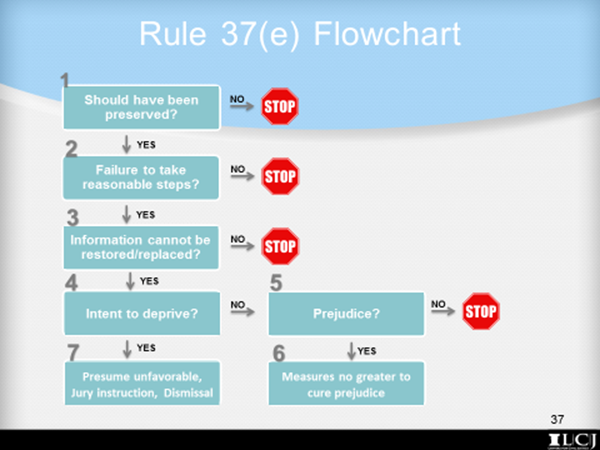
Now that the amendments affecting the rules regarding the bringing of a case and case management procedures, as well as those changes to the scope of discovery have been discussed, the final piece of this guide addresses the changes to preservation requirements and the new rule governing sanctions—or remedies—for ESI spoliation. Rule 37(e) has been completely redesigned, and now functions as the sole authority for dealing with lost or destroyed ESI. As a result, the amended rule has broad implications not only for the legal community but the business community, too.
Changes to Preservation Requirements and Potential for Sanctions—Rule 37(e)
| Previous Rule | Amended Rule | |
| Rule 37(e) | (e) Failure to Provide Electronically Stored Information.
Absent exceptional circumstances, a court may not impose sanctions under these rules on a party for failing to provide electronically store information lost as a result of the routine, good-faith operation of an electronic information system |
(e) Failure to Preserve Electronically Stored Information.
If electronically stored information that should have preserved in the anticipation or conduct of litigation is lost because a party failed to take reasonable steps to preserve it, and it cannot be restored or replaced through additional discovery, the court:
(1) upon finding prejudice to another party from loss of the information, may order measures no greater than necessary to cure the prejudice; or
(2) only upon finding that the party acted with the intent to deprive another party of the information’s use in the litigation may: A. presume that the lost information was unfavorable to the party; B. instruct the jury that it may or must presume the information was unfavorable to the party; or C. dismiss the action or enter a default judgment. |
What was once a simple, 36-word paragraph is now a multi-faceted sanctions analysis that applies once a duty to preserve electronically stored information (ESI) is triggered and ESI is, nevertheless, lost.
When Does Rule 37(e) Apply: There are three initial conclusions that must be reached for Rule 37(e) to apply:
- That ESI, which should have been preserved, was lost;
Step One: The first issue presented by Rule 37(e) is determining whether a duty to preserve had been triggered, and when. This is because the new Rule 37(e) only applies when both ESI is lost and that ESI should have been preserved because a duty to preserve had been triggered. Precisely defining when a duty to preserve is triggered is beyond the scope of this post, but it should not be overlooked when faced with a Rule 37(e) motion for sanctions. The committee notes to Rule 37(e) also provide a useful primer on the factors affecting whether and when a duty to preserve will arise. Generally, Rule 37(e) suggests that this occurs when litigation is anticipated.
- That the ESI was lost because the party failed to take reasonable steps to preserve the lost information; and
Step Two: While it may not appear at first glance, the new Rule 37(e) provides a safe harbor for producing parties. This “safe harbor” applies if the party can convince the court that it took “reasonable steps to preserve” the ESI that is now lost. In fact, the committee notes explicitly direct that Rule 37(e) “is inapplicable when the loss of information occurs despite the party’s reasonable steps to preserve.”
The committee also suggested that various factors, such as whether a routine, good-faith operation of an electronic information system was in place, should be considered in determining whether “reasonable steps” were taken. This further reinforces the need for not only formal document retention policies, especially for electronic documents and data, but also for those policies to be followed.
Additionally, the committee advised that courts should also consider a party’s “sophistication” in evaluating whether reasonable steps were taken, particularly considering the staff and resources of the party, as well as the party’s litigation experience. In short, the rule provides a “safe harbor” for those parties that took reasonable steps to preserve ESI, even if that ESI was still lost. This is good news for many companies, small businesses, and individuals that have reasonable document retention policies in place, but may not be accustomed to the overwhelming demands that are sometimes placed on the production of ESI in certain types of litigation. In these situations, even if ESI is no longer available, these companies, small businesses, and individuals may now be protected from sanctions under the safe-harbor provision.
- That the lost information cannot be restored or replaced through additional discovery.
Step Three: Finally, sanctions are only considered under Rule 37(e) if the information cannot be restored or replaced through additional discovery. This means that the court may, instead of issuing sanctions, authorize additional discovery to determine whether the lost information can be restored or replaced. That being said, the committee has suggested that in deciding whether restoring lost information is required, the court must consider whether those efforts are proportional to the apparent importance of the lost information to claims or defenses in the litigation. In fact, the committee specifically noted that “substantial measures should not be employed to restore or replace information that is marginally relevant or duplicative.”
Sanctions for “Lost” ESI: If a duty to preserve was triggered, the party is not protected by the safe-harbor provision, and the information cannot be restored or replaced, then sanctions which are “no greater than necessary to cure the prejudice” may be ordered by the court under Rule 37(e)(1). Before such measures can be taken, though, the court must conclude that the loss of the information prejudiced the other party. The committee has instructed that such an evaluation of prejudice necessarily requires the court to consider the information’s “importance in the litigation.” In these instances, though, once there is a finding of prejudice, judges have broad remedial powers, which are limited only by the instruction that the measure provided is no greater than necessary to cure the prejudice.
Sanctions for “Destroyed” ESI: Only when there is evidence to suggest ESI was destroyed—that is, ESI was lost with an “intent to deprive” the harmed party of the information—will harsher sanctions be available under Rule 37(e)(2). Under these circumstances, though, the sanctions are indeed, harsh.
Before these very severe sanctions of Rule 37(e)(2) can be issued, the court must find that the party acted with the intent to deprive another party of the information’s use in the litigation. The committee explained that Rule 37(e)(2) would not apply upon a finding of mere negligence, or even gross negligence. It is important to note, however, that there is not a requirement that the judge find prejudice to the party deprived of the information.
Once the court finds this “intent to deprive”, it may choose to presume that the lost information was unfavorable to the party when ruling on a pretrial motion or presiding at a bench trial. See Rule 37(e)(2)(A). Or, the court could issue an instruction either permitting or requiring the jury to presume or infer that the lost information was unfavorable to the party that lost it. See Rule 37(e)(2)(B). Finally, as the harshest of measures, the court is authorized by Rule 37(e)(2)(C) to dismiss the action or enter a default judgment as a result of the destroyed ESI.
Such sanctions are not automatic, however, as a court is not required to issue these sanctions, even if an intent to deprive is found. The committee recognized that “[t]he remedy should fit the wrong”, and therefore, if the information was relatively unimportant, then it is possible that a lesser measure—like that provided in Rule 37(e)(1)—may be sufficient to redress the loss of information.
The Lawyers for Civil Justice have published a number of informative materials regarding the amendments to the Federal Rules of Civil Procedure, including an educational PowerPoint containing the following flowchart that illustrates the new Rule 37(e):
PowerPoint Presentation on the Amendments for Education Purposes, Lawyers for Civil Justice, http://www.lfcj.com/uploads/3/8/0/5/38050985/lcj_intro_to_2015_frcp_amendments.pptx (last visited Jan. 12, 2016).
As amended, Rule 37(e) stands as the single rule authorizing federal courts to impose measures to remedy ESI spoliation, whether it be lost ESI or destroyed ESI. As a result, this new rule has a significant impact on not only the legal community but also the business community, as it necessarily shapes preservation guidelines and influences behavior to ensure that reasonable steps are taken to fall within Rule 37(e)’s safe-harbor provision rather than the severe sanctions of Rule 37(e)(2). For more guidance on the practical side of Rule 37(e), see the various publications issued by the Sedona Conference. The Guidelines provided in the Sedona Conference’s Commentary on Legal Holds are particularly instructive as to what may constitute the “reasonable steps” required to fall within the safe-harbor provision of the rule.
*************************************************************************************
On February 11, 2016, the Federation of Defense & Corporate Counsel hosted a free webinar to discuss recent federal-court decisions on the amended rules, the retroactive application of the new rules, and feedback from practicing attorneys on their experiences with the amended rules.
